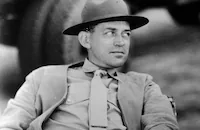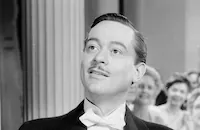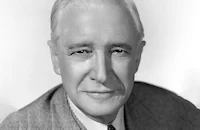His Brother's Wife

Brief Synopsis
Cast & Crew
W. S. Van Dyke
Barbara Stanwyck
Robert Taylor
Jean Hersholt
Joseph Calleia
John Eldredge
Film Details
Technical Specs

Synopsis
As a deadly spotted-fever epidemic rages in the jungle, the owners of the Rothmore Mines implore Dr. "Pop" Fahrenheim, the leading scientist at the Rothmore Institute, to leave New York and travel to the jungle for two years to find a cure. His assistant, Chris Claybourne, the playboy son of the famous Dr. Claybourne, agrees to go with him, but wants a two-week fling before the trip. At a crooked gambling club run by "Fish-Eye," Chris loses five thousand dollars on credit. That same night he meets model Rita Wilson, who has refused Fish-Eye's proposition that she lure wealthy escorts to his gaming tables for a percentage. Though they are strongly attracted to each other, Chris and Rita agree not to fall in love, but spend his spree together, having fun and swiping unusual hats. As Chris's departure day approaches, however, they realize that they are in love and Chris promises not to go to the jungle. That same night, Fish-Eye forces Chris to sign a check for his debt, and gives him until the next afternoon to make it good. As Dr. Claybourne's money is all used to support his hospital, Chris' only hope is his staid brother Tom. When Chris takes Rita to meet Tom, however, Tom tells his brother that he will only help him if he goes to the jungle and waits to marry Rita, whom he considers socially inferior, until he returns. Rita, enraged, tells Chris that they are through and secretly goes to Fish-Eye to arrange to pay off Chris' debt by working for him. Some time later, while Chris waits in vein for letters from Rita, Tom goes to Fish-Eye's club and sees Rita. She then admits that she was the person who secretly paid the debt, but lies and says that her grandmother left her the money. She engratiates herself to Tom by telling him how right he was and "confessing" that she merely had a crush on Chris. On Christmas Eve, Chris suddenly returns to New York on a leave-of-absence and learns that Tom has broken with his fiancée and has just been asked to resign from the hospital for neglect of duty. Though Dr. Claybourne does not know what has happened to Tom, Tom privately tells Chris that he fell in love with Rita and secretly married her, after which she laughed at his stupidity and refused to see him. Now believing that Tom's original opinion of Rita was true, Chris goes to Fish-Eye's club and finds her. She confesses her mistakes and is remorseful, and, because she still loves Chris, agrees to his plan that she accompany him back to the jungle, on a platonic basis, to wait for Tom to agree to a divorce. Several months later, when Chris finally receives word from his father that Tom has obtained his divorce and has gone back to work, Rita is ecstatic until Chris bitterly reveals that this was all part of his plan to get back at her. Though Pop tells him what a fool he is, he sends her away, and refuses her offer to let them test their new serum on her. Pop has been ordered to leave by the local government, but he and Chris go to a remote part of the jungle to test their serum on Chris. Suddenly worried about injecting Chris with the disease, though, he breaks the bottle of serum to delay the test. When Rita learns what they are about to do, she rushes to them and secretly injects herself with the disease instead, because she has nothing to live for. Now realizing he still loves Rita, Chris works feverishly to make more serum. Soon Chris and the recuperated Rita marry and sail back to New York. As he wistfully eyes the captain's hat, Chris promises Rita that when they return to the jungle to build a hospital, he will let her be a part of his work.

Director

W. S. Van Dyke
Cast

Barbara Stanwyck

Robert Taylor

Jean Hersholt

Joseph Calleia

John Eldredge

Samuel S. Hinds
Phyllis Clare

Leonard Mudie
Jed Prouty
Pedro De Cordoba
Rafael Corio
William Stack
Edgar Edwards
Orrin Burke
Sherry Hall
George Davis
Sid Saylor
Ines Palange
Crew
Harold Adamson
George Auerbach
Walter Donaldson
Cedric Gibbons
Leon Gordon
Oliver T. Marsh
Harry Mcafee
John Meehan
Conrad A. Nervig
Joseph Newman
Al Raboch
Douglas Shearer
Tess Slesinger
William Steinkamp
Dolly Tree
W. S. Van Dyke
Franz Waxman
Lawrence Weingarten
Edwin B. Willis

Film Details
Technical Specs

Articles
His Brother's Wife
The ludicrous and convoluted plot has Taylor as a playboy turned dedicated doctor who's about to go to South America to look for a cure for spotted fever. Stanwyck is a model who meets him in a gambling den. After a whirlwind romance, he leaves, and she marries his brother to spite Taylor. Several ridiculous plot complications later, she ends up in South America. Stanwyck, distraught at being rejected by Taylor injects herself with the fever virus and he must save her. The whole mess was directed at a speedy clip by W.S. "One-Take Woody" Van Dyke, but he couldn't disguise the shoddiness of the screenplay.
The reviews for His Brother's Wife were mixed at best. Kate Cameron of the New York Daily News tried to find something to like about it: "It is marked by the adroit acting of Barbara Stanwyck and Robert Taylor in the leading roles. It has been well photographed and expensively mounted." Frank Nugent of the New York Times was more blunt: "A triumph of machine-made art, it is a picture that will succeed no matter how we, in our ivory tower, rail against it for its romantic absurdity." Stanwyck agreed, saying that the film set movies back twenty years. But Nugent was right; the fan magazines' breathless reporting of the off-screen romance between Stanwyck and Taylor paid off with box office success.
What does come through in His Brother's Wife, however, is the fervent sincerity of the love scenes. They may have seemed an odd couple - Stanwyck, four years older than Taylor, was tough and streetwise; the Nebraska-bred Taylor gentlemanly and naïve - but the romance endured. The couple made another film together, This Is My Affair (1937), and married in 1939. They divorced 11 years later because of his infidelity, but they maintained a mutual respect, and Stanwyck reportedly never got over Taylor. They co-starred one more time, in The Night Walker (1964). In recent years, dubious biographies have claimed that both Stanwyck and Taylor were gay, and that their romance was cooked up by MGM publicity chief Howard Strickling to quiet talk of Taylor's homosexuality. But those rumors have been denied by those who knew both.
Director: W.S. Van Dyke
Producer: Lawrence Weingarten
Screenplay: Leon Gordon, John Meehan, based on a story by George Auerbach
Cinematography: Oliver T. Marsh
Editor: Conrad A. Nervig
Costume Design: Dolly Tree
Art Direction: Cedric Gibbons
Music: Franz Waxman
Principal Cast: Barbara Stanwyck (Rita Wilson), Robert Taylor (Chris Claybourne), Jean Hersholt (Professor Fahrenheim), Joseph Calleia (Fish Eye), John Eldredge (Tom Claybourne), Samuel S. Hinds (Dr. Claybourne), Phyllis Clare (Clara), Leonard Mudie (Pete), Jed Prouty (Bill Arnold), Pedro de Cordoba (Dr. Capolo).
BW-88m.
by Margarita Landazuri

His Brother's Wife
Quotes
Trivia
Notes
A working title of the film was My Brother's Wife. According to a Hollywood Reporter news item from April 10, 1934, E. A. Dupont was initially set to director the picture, which was to be written by Zelda Sears and Eve Greene. Sears and Greene are not mentioned in any sources after 1934, and the extent of their participation in the produced film has not been ascertained. News items from 1935 and 1936 note that Jean Harlow and Clark Gable were initially cast in the leads, then Harlow and Franchot Tone, and that Richard Boleslawski was to direct. Though Edith Atwater and Frank Puglia are included in the CBCS list, they were not in the viewed print, nor were their characters contained in the cutting continuity of the film. Atwater's character, "Mary," was the name of character Tom Claybourne's fiancée, however the character was not seen. Atwater's part, as well as that of "Hotel clerk" played by Puglia, May have been cut from the film prior to final editing, but after their names appeared on the CBCS list. According to a news item in Hollywood Reporter, director W. S. Van Dyke completed filming in "close to record speed for this type of picture," in 13 1/2 days from a 137 page script. It was the first of three films that co-starred Robert Taylor and Barbara Stanwyck, who were married between 1939 and and 1952. Their last film together was The Night Walker, directed by William Castle in 1964 for Universal.















